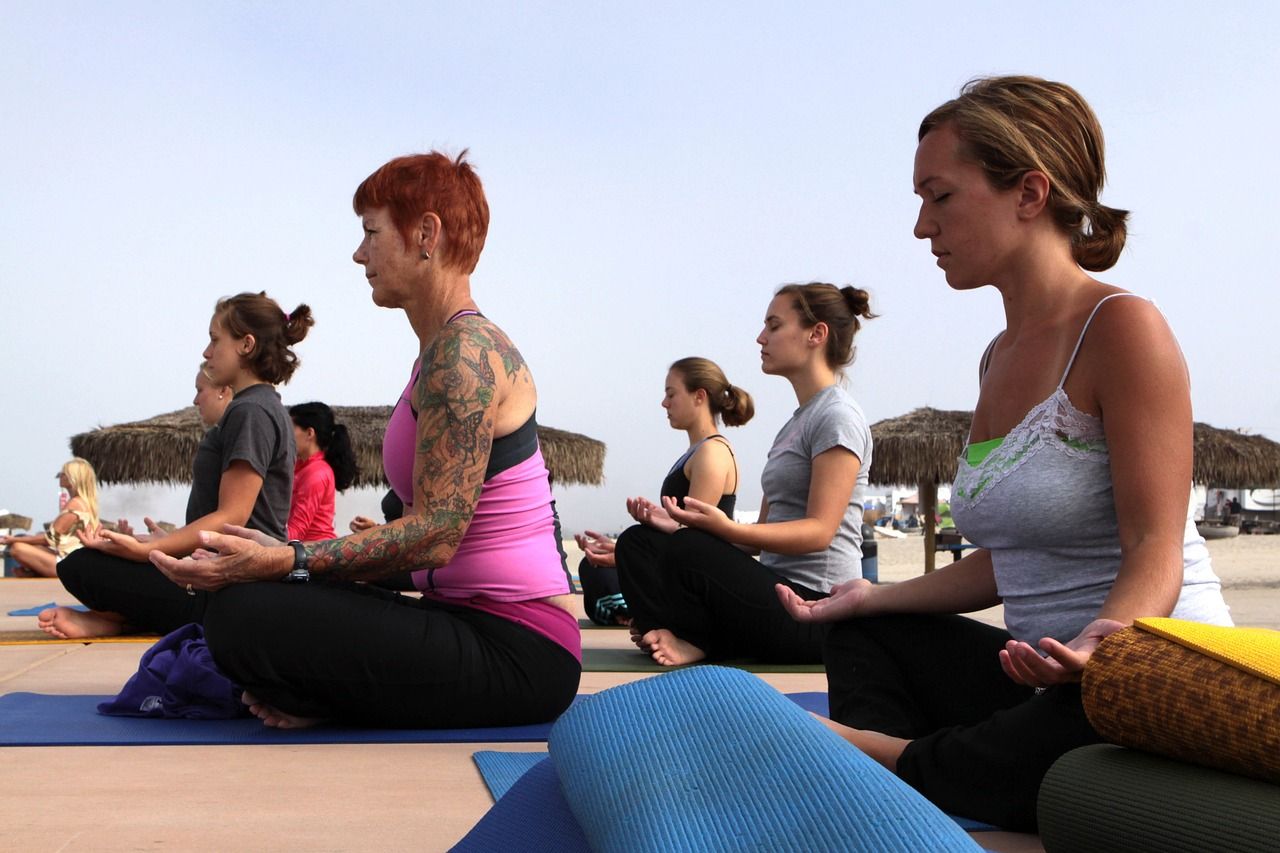5 EASY Mindfulness Practices That Will Change Your Life
5 EASY Mindfulness Practices That Will Change Your Life
Mindfulness meditation: It will change your life…if you’re patient enough to do it. People who practice mindfulness will talk all day about the amazing benefits of mindfulness practices and techniques. I hear over and over people tell me, “I’m not good at mindfulness” or “I don’t like mindfulness practices.”
Learning how to do mindfulness is as simple as googling, “ways to practice mindfulness.”
Yet, actually DOING the mindfulness exercises is a whole other ball game. It takes patience, the ability to slow down, and great mental strength.
Once you make it a habit, mindfulness
will change your life. You just have to be open to trying it.

What IS Mindfulness?
Before getting into the best mindfulness practices, first, let’s talk about what mindfulness is.
According to the Mayo Clinic, mindfulness is “a type of meditation in which you focus on being intensely aware of what you're sensing and feeling in the moment, without interpretation or judgment.” (1)
Now, onto mindfulness practices you can do in your daily life!
One of the most common reasons people begin mindfulness practices is for anxiety and stress. Using mindfulness for anxiety has extreme positive impacts on people’s anxiety levels and management. The impact of mindfulness practices for anxiety are phenomenal. (2)(3)(4)
Benefits Of Mindfulness
Anxiety Management
One of the most common reasons people begin mindfulness practices is for anxiety and stress. Using mindfulness for anxiety has extreme positive impacts on people’s anxiety levels and management. The impact of mindfulness practices for anxiety are phenomenal. (2)(3)(4)

Depression Management
Another incredible benefit of mindfulness meditation is the effects it has on depression. People use mindfulness for depression management regularly because mindfulness practices are consistently linked to decreasing depressive symptoms and increasing happiness. (2)(3)(4)

ADHD Management
A not as well-known benefit of mindfulness practices is for ADHD. Many people with ADHD use mindfulness for ADHD coping and management. And to their benefit, it works! Mindfulness techniques are effective in coping with ADHD and have been consistently linked to a decrease in ADHD symptoms. (5)(6)

Pain Relief
Interestingly enough, another unusual but cool benefit of mindfulness practices is pain relief. Study after study has shown mindfulness meditation helps ease and relieve physical pain by engaging specific regions in the brain. (7)(8)

Better Memory
Mindfulness practices are also an effective way to boost your memory. (9) In fact, one study showed that just 10 minutes of mindfulness meditation improves your memory.(10) Imagine what doing 10 minutes every day would do!

Increased Self-Control
Yep, mindfulness fuels and increases self-control. (11)(12) If you (like me) sometimes lack the self-control you want (and need), give mindfulness practices a try!

Mindfulness Practices
And now, ladies and gentleman, what you’ve been waiting for: how to actually practice mindfulness. Learning how can you practice mindfulness in my daily life is much simpler than you think.
Before we run through some basic mindfulness practices and techniques to get you started on your journey; remember at its core, mindfulness is living and being aware in and of the present moment, noticing your current experience, such as mindful coloring or being present to the sounds and senses in nature. This is different from meditation which is more like choosing to focus on something specific like your breathing or a visualization. You can learn to be in the present moment with the following Mindfulness Practices.
1. Mindfulness Grounding
Mindfulness grounding is an exercise that you can do at any moment throughout your day. I like to do it when I feel stress beginning to take control.
Grounding means essentially to bring your awareness to the present moment by using your senses. Plus, this technique is pretty simple:
All you have to do is name, in the present moment,…
- 5 things you SEE
- 4 things you FEEL
- 3 things you HEAR
- 2 things you SMELL
- 1 thing you TASTE
2. Breathing Techniques
An essential part of mindfulness meditation is breathing. When you notice your breathing patterns, you become aware of your mental state and how it’s affecting your body. By pausing and taking deep breaths, you calm your nervous system down.
While there are an infinite number of breathing exercises, we will focus on two simple ones for this article
Diaphragmatic (Belly) Breathing
- Sit or lie down in a comfortable position
- Put one hand on your chest and the other on your stomach
- Take one slow breath IN as deep as you can. FEEL your stomach push your hand.
- Try to keep your chest as still as possible
- Breathe OUT through pursed lips
- Feel the hand on your belly go in with your belly, and push all the air out.
- Repeat 3-5 times.
4-7-8 Breathing
- Breath in deeply for 4 seconds
- Hold breath for 7 seconds
- Breath out through pursed lips for 8 seconds
- Repeat
There are numerous breathing exercises, but these are two that are tried and true and a great way to get started.
3. Body Scan
Our next mindfulness exercise is a body scan. The purpose of this exercise is to place your awareness back into your body and the present moment.
To DO a body scan, you only need a few minutes.
- Sit upright in a comfortable chair
- Close your eyes
- Become aware of your feet. Notice how you are directing and in control of where your conscience goes.
- Focus on each part of your foot: how it feels, what it feels, what it’s doing.Sslowly, move to every part of your foot.
- Eventually move onto your ankles.
- Then calves and shins
- And so on until you’re at the top of your head.
- Spend as long as you need on each part of your body and be aware of how everything feels, where you’re holding tension, and how your conscience is moving to each part.
- Once you’ve moved to every part of your body, become aware of the body as a whole, and flood your awareness to every part of your body.
This technique is an excellent way to reset your mind, calm your nervous system, and be in the present moment.
4. Mindful Walking
Of all the mindfulness practices around, the best one to increase physical activity as well as awareness is mindful walking.
And it’s easy!
All you have to do is go for a walk and…
- Be aware of HOW your body is moving- how your legs move, how your arms sway
- Notice the things you pass- their colors, their smells, and how they move
- Focus on how every part of your body FEELS as your walk
- Focus on every SMELL you smell as your walking
- Focus on every SOUND you hear as your walking
On top of being aware of your surroundings on your mindful walk, you can also speak words to yourself such as…
- I am placing my right foot forward and now my left foot
- I hear a bird singing
- The wind is blowing in my face and my hair is flying back
- Etc, etc
Essentially just stating everything you feel, see, hear, or smell.
5. Mindful Eating
Another awesome mindfulness practice is mindful eating. If you’re not used to being mindful, this is a powerful way to start practicing!
For mindful eating, all you have to do is view eating as an experience instead of something to rush through by…
- Eating Slowly
- Not doing anything else while you’re eating
- Focusing on how your food smells
- Chewing every bite until it’s completely chewed up
- Experiencing the tastes and the feel of every food
- Only eating when you’re physically hungry
Mindful eating is a fabulous technique that allows you and your body to slow down and live in the present moment…you can practice this three times a day with each meal, it’s a wonderful place to start!
Bring Mindfulness Practices Into Your Daily Routine
If all these mindfulness practices seem overwhelming to you, it’s okay! Take a deep breath and know, you don’t have to do all of them. Start small and do it with something you already do daily. This gives you a chance to practice consistently and we all know the adage “practice makes perfect.” No need to expect perfection, but rather consider if a work in progress.
One way to begin bringing mindfulness practices into your daily routine is to set aside specific time in your day to do a mindfulness breathing exercise, body scan, grounding, or a mindful walk. Another way is just to start with mindful eating!
So my challenge to you is to choose a time day and for the next week, dedicate that time to trying just ONE of these life-changing mindfulness practices! Watch how much it affects your mind and life. In the best way possible.
REFERENCE:
- “Mindfulness exercises.” Mayo Clinic, https://www.mayoclinic.org/healthy-lifestyle/consumer-health/in-depth/mindfulness-exercises/art-20046356. Accessed 12 March 2024.
- Hofmann SG, Sawyer AT, Witt AA, Oh D. The effect of mindfulness-based therapy on anxiety and depression: A meta-analytic review. J Consult Clin Psychol. 2010 Apr;78(2):169-83. doi: 10.1037/a0018555. PMID: 20350028; PMCID: PMC2848393.
- Gallego, José, et al. "Effect of a mindfulness program on stress, anxiety and depression in university students." The Spanish journal of psychology 17 (2014): E109.
- Hofmann, Stefan G., and Angelina F. Gómez. "Mindfulness-based interventions for anxiety and depression." Psychiatric clinics 40.4 (2017): 739-749.
- Zylowska, Lidia, et al. "Mindfulness meditation training in adults and adolescents with ADHD: A feasibility study." Journal of attention disorders 11.6 (2008): 737-746.
- Lee CSC, Ma M-T, Ho H-Y, Tsang K-K, Zheng Y-Y, Wu Z-Y. The Effectiveness of Mindfulness-Based Intervention in Attention on Individuals with ADHD: A Systematic Review. Hong Kong Journal of Occupational Therapy. 2017;30(1):33-41. doi:10.1016/j.hkjot.2017.05.001
- Zeidan F, Grant JA, Brown CA, McHaffie JG, Coghill RC. Mindfulness meditation-related pain relief: evidence for unique brain mechanisms in the regulation of pain. Neurosci Lett. 2012 Jun 29;520(2):165-73. doi: 10.1016/j.neulet.2012.03.082. Epub 2012 Apr 6. PMID: 22487846; PMCID: PMC3580050.
- Zeidan, Fadel, et al. "Mindfulness meditation-based pain relief employs different neural mechanisms than placebo and sham mindfulness meditation-induced analgesia." Journal of Neuroscience 35.46 (2015): 15307-15325.
- Jha, Amishi P., et al. "Does mindfulness training help working memory ‘work’better?." Current opinion in psychology 28 (2019): 273-278.
- Lueke, Adam, and Niloufar Lueke. "Mindfulness improves verbal learning and memory through enhanced encoding." Memory & cognition 47.8 (2019): 1531-1545.
- Elkins-Brown, Nathaniel, Rimma Teper, and Michael Inzlicht. "How mindfulness enhances self-control." Mindfulness in social psychology. Routledge, 2017. 65-78. https://www.researchgate.net/profile/Nathaniel-Elkins-Brown/publication/303002274_How_Mindfulness_Enhances_Self-Control/links/573502cc08ae9f741b28346e/How-Mindfulness-Enhances-Self-Control.pdf
- Bowlin, Stephanie L., and Ruth A. Baer. "Relationships between mindfulness, self-control, and psychological functioning." Personality and individual differences 52.3 (2012): 411-415.
13. www.grlcopywriting.com




